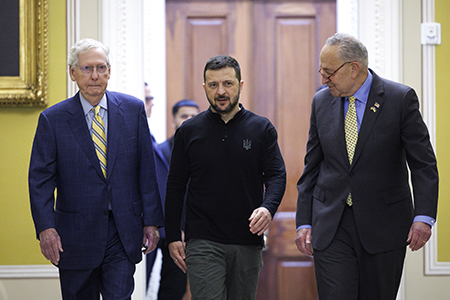Ukraine Presses Request To Use U.S.-Origin Long-Range Missiles
October 2024
By Xiaodon Liang
The United States continues to weigh a request from Ukraine to use U.S.-origin missiles against targets deep behind the frontlines of the continuing full-scale Russian invasion.

At a Sept. 6 meeting in Ramstein-Miesenbach, Germany, of states supporting the Ukrainian war effort, Ukrainian President Volodymyr Zelenskyy renewed a call on the United States and other countries to permit use of long-range missiles against “the Russian territory so that Russia is motivated to seek peace.”
In his statement, Zelenskyy referred not only to the U.S.-supplied Army Tactical Missile System (ATACMS), a ground-launched ballistic missile, but also weapons provided by other countries that incorporate U.S. components or licensed technology, such as the French-British Storm Shadow/SCALP-EG air-launched cruise missile.
Although Ukraine referred to these weapons as “long-range” systems, the ATACMS is a short-range ballistic missile with an estimated range of 300 kilometers. The Storm Shadow/SCALP-EG missile has an estimated range of up to 550 kilometers. (See ACT, June 2024; November 2023.)
U.S. President Joe Biden discussed the Ukrainian request in a Sept. 13 meeting with UK Prime Minister Keir Starmer in Washington, but no change in U.S. policy was announced following the event. Starmer is understood to have argued in favor of Ukraine’s request at the meeting, the Associated Press reported.
U.S. officials are skeptical that permitting deep strikes with U.S.-origin missiles into Russia will create a military advantage for Ukraine. In a statement to the Associated Press, a Pentagon spokesperson said that ATACMS missiles do not have the range to target Russian combat aircraft that deliver glide bombs, which are now a priority threat for Ukraine.
Following the Sept. 6 meeting in Germany, U.S. Defense Secretary Lloyd Austin, responding to a question about long-range strikes, said, “I don’t believe that one specific capability is going to be decisive.” Speaking at a U.S. Air Force base in Alabama a week later, Austin pointed out that Ukraine has conducted successful deep strikes with its own drone systems. (See ACT, July/August 2024.)
U.S. officials also are concerned that Russia might respond to a U.S. decision to approve Zelenskyy’s request by providing Iran with technological support to target U.S. forces in the Middle East, The New York Times reported on Sept. 12.
Russian President Vladimir Putin warned on Sept. 12 that acceding to the Ukrainian request would mean that the United States and other providers of missiles “are parties to the war in Ukraine.”
“This will mean their direct involvement in the conflict, and it will clearly change the very essence, the very nature of the conflict dramatically,” he said in a comment to the press in St. Petersburg.
In response, John Kirby, the White House national security communications adviser, said at a Sept. 13 press conference that “we take these comments seriously, but it is not something that we haven’t heard before.” In a Sept. 17 interview with The Times of London, NATO Secretary-General Jens Stoltenberg said, “[T]here have been many redlines declared by [Putin] before, and he has not escalated.”
Zelenskyy is scheduled to meet Biden on Sept. 26 on the sidelines of the UN General Assembly in New York, the White House said.
